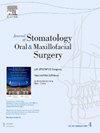Recurrent pleomorphic adenoma: Epidemiology and surgical challenges; a single tertiary center experience
IF 1.8
3区 医学
Q2 DENTISTRY, ORAL SURGERY & MEDICINE
Journal of Stomatology Oral and Maxillofacial Surgery
Pub Date : 2024-11-23
DOI:10.1016/j.jormas.2024.102164
引用次数: 0
Abstract
Introduction
Despite being less common in recent years, recurrent pleomorphic adenoma still poses a surgical challenge, especially after improper surgery.
Methods
We retrospectively recruited all patients with recurrent pleomorphic adenoma and Carcinoma ex pleomorphic adenoma from February 2007 to April 2024 who were operated upon in a tertiary cancer center. Epidemiological, radiological, and pathological data, risk factors, details of surgical treatment, and surgical/oncological outcomes were analyzed.
Results
35 patients with recurrent pleomorphic adenoma were recruited, 19 were women (54.3 %) with the parotid gland being the most affected site in 74.3 % followed by the submandibular gland in 20 %. Only 11 patients (31.4 %) underwent surgery for the primary tumor in our center, and of interest that 48.6 % of the total cohort underwent simple enucleation for their primary tumors. The interval between resection and recurrence was shortened with frequent recurrences. Again, 71.4 % of facial nerve injuries had a history of simple enucleation for their primaries. 3 cases of Carcinoma ex pleomorphic adenoma were reported, representing 1.4 % of the patients with parotid pleomorphic adenoma in the study period, and was associated with young age and long-standing recurrence.
Conclusions
Surgery is the cornerstone treatment for both primary and recurrent pleomorphic adenoma. Inadequate primary surgery, long-standing lesions, multiplicity, and fragmentation may be associated with facial nerve injury. Reconstructive flaps may be needed to cover the large resultant defects. Surgery for pleomorphic adenoma should be done by adequately trained surgeons. Radiation as an adjuvant treatment needs to be used frequently, especially through a multidisciplinary approach. Carcinoma ex pleomorphic adenoma, being rare, is demanding in its management with a poor prognosis.
复发性多形性腺瘤:流行病学和手术挑战;一个三级中心的经验。
简介:尽管近年来复发性多形性腺瘤的发病率有所下降,但它仍然是手术治疗的难题:尽管近年来多形性腺瘤的发病率有所下降,但复发性多形性腺瘤仍然是一个手术难题,尤其是在手术不当的情况下:我们回顾性地收集了2007年2月至2024年4月期间在一家三级癌症中心接受手术的所有复发性多形性腺瘤和多形性腺瘤癌患者。研究人员对这些患者的流行病学、放射学和病理学数据、风险因素、手术治疗细节以及手术/肿瘤学结果进行了分析:共招募了35名复发性多形性腺瘤患者,其中19名为女性(占54.3%),74.3%的患者发病部位为腮腺,其次是颌下腺,占20%。在我们中心,只有11名患者(31.4%)接受了原发肿瘤手术,值得注意的是,48.6%的患者接受了原发肿瘤单纯去核手术。由于复发频繁,切除与复发之间的间隔时间缩短。同样,71.4%的面神经损伤患者的原发肿瘤曾接受过单纯去核手术。有3例腮腺多形性腺瘤癌,占研究期间腮腺多形性腺瘤患者的1.4%,与年轻和长期复发有关:结论:手术是治疗原发性和复发性多形性腺瘤的基石。结论:手术是治疗原发性和复发性多形性腺瘤的基石。原发性手术不充分、病变长期存在、多发性和碎裂可能与面神经损伤有关。可能需要重建皮瓣来覆盖由此造成的巨大缺损。多形性腺瘤手术应由训练有素的外科医生进行。需要经常使用放射治疗作为辅助治疗,尤其是通过多学科方法。多形性腺瘤外癌虽然罕见,但治疗要求高、预后差。
本文章由计算机程序翻译,如有差异,请以英文原文为准。
求助全文
约1分钟内获得全文
求助全文
来源期刊

Journal of Stomatology Oral and Maxillofacial Surgery
Surgery, Dentistry, Oral Surgery and Medicine, Otorhinolaryngology and Facial Plastic Surgery
CiteScore
2.30
自引率
9.10%
发文量
0
审稿时长
23 days
 求助内容:
求助内容: 应助结果提醒方式:
应助结果提醒方式:


